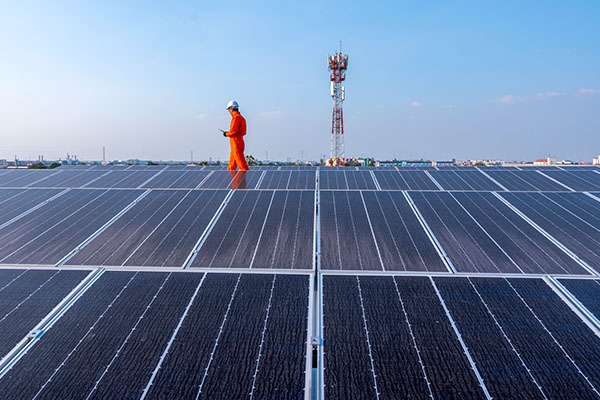How your network enables cloud sustainability
Cloud sustainability represents the environmental impact that companies can realize through cloud computing services. Built on a foundation of cloud connectivity, which is enabled by business internet, cloud sustainability is more energy- and resource-efficient than traditional on-site, physical data processing and storage. Because of the shift from traditional hardware-based operations, which consume a significant amount of energy and instigate higher greenhouse gas emissions (GHGs), it has a positive impact on environmental sustainability.
What’s now considered cloud computing first arose in the mid-1990s. Companies began to track the applications that operated through the internet. This was the birth of software as a service (SaaS)1.
Today, with the increased prevalence of companies having a distributed workforce, cloud services are essential for flexible business operations, allowing files and programs to be accessed from anywhere. Cloud sustainability is a beneficial byproduct of that evolution.
Why is there pressure for cloud sustainability?
There’s no question that atypical climate events are becoming more frequent. Science continues to be collected and validated about how the world’s consumption of resources and processing of waste influence climate change. Consumers across the globe—primarily younger consumers who are recognizing their purchasing power—are demanding environmentally-friendly products and shopping formats.2 Taking it a step further, they want greater transparency about sustainability practices from the companies that do business with, and in the job market, those that they work for.
This voice is being echoed into the halls of government where federal regulators are responding to voters who want environmental accountability from businesses. They’re also responding to how climate events are impacting society. Seeing the effect… and resulting financial impact of federal disaster spending for climate-related events, more lawmakers are pushing for a proactive, rather than a reactive, approach to this challenge. Their focus begins with the industries that are the greatest contributors to greenhouse gas emissions (GHGs), which are the leading contributors to negative environmental sustainability. They’re imposing new rules and regulations not only specific to certain industries, but to the companies that put products and services into the hands of consumers.
In response, business leaders are looking holistically at opportunities to reduce emissions enterprise-wide, including in IT infrastructure. As of 2022, an impressive 96% of the world’s top 250 companies reported their sustainability goals.3 For some companies, actively meeting their goals may seem like a monumental challenge, however, effectively using technology can help consolidate efforts across the business. This can result in a lower energy consumption and improved sustainability, not to mention, it may lower costs, including hidden costs related to energy. The outcome? Improved environmental sustainability. Leveraging the benefits of the cloud is one such technology.
As part of broader sustainability efforts, using the cloud for sustainability offers a distinct opportunity to achieve a balance between reducing the emissions footprint of business technology use while still being competitive. By moving from on-premises hardware to cloud-based software, companies can lower capital costs while reducing energy consumption, waste, and GHGs.
How does cloud sustainability work?
It’s clear that enterprises recognize the general benefits of cloud computing. Approximately 94% have adopted cloud services. Sixty-four percent of enterprise architecture is cloud-based, and 92% of businesses have a multi-cloud strategy active or on their roadmap.4
When a business shifts to cloud computing, it receives computing services, such as servers, data storage, networking, analytics, etc., over the internet, instead of owning and maintaining its own computing infrastructure. This allows the company to leverage off-site cloud providers on an as-needed basis. Through this they gain cost efficiencies and decrease their administrative burden, in addition to the environmental benefits.
Cloud sustainability can be considered from two main angles: hardware and software. The focus of cloud sustainability is to gain agility and scalability. However, a key benefit is that this shift helps to minimize the hardware that’s needed for business operations and to shift more operations to the cloud. This is accomplished through cloud-related technologies like Network Functions Virtualization, which separates hardware from software into virtual network functions. These are then consolidated into a single device rather than many that runs multiple virtual network functions. Because this occurs virtually, the energy required is significantly reduced.
Benefits of cloud sustainability
Cloud sustainability translates computing efficiencies into cost reductions for your business. Some of these efficiencies include:
- Energy efficiency: Moving file storage and other computing needs to the cloud minimizes your physical server footprint, consuming less electricity, and producing fewer associated GHGs. Eliminating, which need to be cooled, represents significant energy savings. Cloud data centers typically have newer, more efficient equipment than is used in on-premises set-ups. They’re also increasingly run on renewable energy.
- Resource efficiency: Reducing equipment also reduces waste at the end of its lifecycle. Cloud computing leverages server virtualization, which is a way to consolidate servers by running multiple separate workloads on one physical host server5.
- Cost efficiency: On-premises hardware is a capital expenditure (CapEx). Migrating to a cloud-based model enables you to shift to costs to operating expenses (OpEx). These are more predictable, flexible, and often offer lower up-front costs.
Note that many businesses must report on Scope 1, 2, and 3 emissions. Scope 1 are the direct, owned carbon emissions—those that a company controls itself. Scope 2 and 3 are indirect emissions are those from collaborators, partners, and service providers that support your business. Not all cloud practices or cloud service providers are focused on supporting cloud sustainability. It is important to select a provider who’s tracking and mitigating its operational footprint so you can meet your overall sustainability goals
When evaluating if a CSP is using practices that are environmentally sustainable, you might ask if they’re:
- Using renewable energy as much as possible to power its center.
- Locating a center in a naturally colder climate to reduce cooling needs.
Integrating artificial intelligence (AI), which can provide automated monitoring and optimization, as discussed below.
What are network requirements for cloud sustainability?
To realize all the benefits of cloud sustainability, your business must maintain strong, reliable network connectivity that provides the bandwidth needed for cloud services. To optimize network performance and have tailored support for cloud sustainability, it’s important to evaluate the infrastructure of your networking services that support cloud. Cloud services and solutions to include in this evaluation are:
- Edge computing solutions help reduce any delays in network communication and enable businesses to maintain security and control over their data. At the same time, businesses can remain flexible in integrating and connecting into a larger range of cloud service providers, serving multiple locations at once.
- On-premise edge solutions help a business increase connectivity, control, and computing when integrating a cloud service provider. This achieves the on-site computing benefit of low-latency, or minimal delays in data processing, to the flexible access of cloud applications.
- Software Defined Wide Area Network (SD-WAN) solutions move network traffic management from hardware on-site to next generation software in the cloud. This approach improves a network’s agility, control and visibility, and lowers the cost of network ownership.
If these services and solutions are not already part of your networking infrastructure, understanding their requirements now will help you to put them on your roadmap and create an efficient network-based action plan.

Driving business success through sustainability
Stay ahead of regulations and reduce energy and resource consumption. Learn why sustainability is important for business and staying resilient in a crisis.
Enabling cloud sustainability with AI and why it can make a difference
Another important technology to consider in your sustainability planning is artificial intelligence (AI). AI can automate monitoring of energy usage, waste generation, and emissions data to optimize resource use. When combined with IoT, you have a very powerful system for conservation.
There are a few main ways that AI can make cloud computing through data centers more environmentally sustainable:
- Help operators design and build lean and smart data centers.
- Identify opportunities to lower energy usage and waste and emissions through workload management.
- Allocate resources based on computing demands for better efficiency and energy consumption, while minimizing downtime.
- Discover energy consumption patterns and their correlation with temperature, time of day, workload, etc. to predict future consumption.
- Monitor equipment performance to predictive maintenance to reduce waste and minimize unscheduled downtime.
- Analyze cooling equipment sensor data to adjust the energy input needed, saving companies up to 40% of the power spend on data center cooling6.
Companies are already successfully leveraging AI within their data centers. For example, AI uses metrics like heat, emissions, and airflow to simulate when a data center would present unsafe working conditions.
Three steps to moving from hardware to software to enable cloud sustainability
What are the steps you need to consider for shifting more of your infrastructure to gain the benefits of cloud sustainability?
- Conduct a cost-benefit study: By directly comparing your business systems to an estimate of what the savings will be from decreased energy and maintenance costs, your business case will become clearer.
- Explore all opportunities for virtualization: As mentioned earlier, Network Functions Virtualization can help you meet sustainability goals. Other technologies include security—both onsite and cybersecurity and cloud-based phone systems and tools. The areas of opportunity continue to expand. Creating a roadmap will help you make holistic changes over time and ensure you’re considering direct and indirect impacts on sustainability with your network plan.
- Evaluate cloud-based service providers: When evaluating cloud service providers, make sure they’re operating with a sustainability-focused model. Doing so enables you to demonstrate improved sustainability in Scope 3 reporting.
Maximizing your network’s energy efficiencies
To more thoroughly reap the benefits of cloud sustainability, the host network must be reliable and be sustainable in itself. As connectivity technologies continue to improve and expand—including with the rollout of 5G over the last few years—networks deliver connections with greater speed, capacity, reliability, and security. 5G networks also provide opportunities to have a net improvement on opportunities for energy efficiency.
Fiber optic technology is considered one of the most efficient networking and data transmission technologies that can enable cloud connectivity. Fiber presents the speed, reliability, and scalability that will be necessary to keep up with increasing cloud sustainability opportunities and demands. A further advantage to fiber is its ability to reduce consumption compared to traditional methods of data transmission. Fiber is more efficient at transmitting signals and lowering energy needs and doesn’t require cooling systems to maintain performance like copper cables do.
Network reliability also leads to better integration of cloud-based technologies like IoT, which enables automation in smart building management. Uses include managed power consumption and HVAC, including thermostats. IoT enables for predictive maintenance, which alerts when an asset is in need of repair. Damaged equipment not only might cause an increase in energy consumption, but it may result in a truck roll… and the vehicle carbon emissions that result from it. And to that end, IoT video intelligence supports remote repairs so a technician can evaluate assets remotely.
When business internet, IoT, and the cloud sustainability are combined for an end-to-end infrastructure, your business can effectively improve your environmental sustainability performance, meeting federal regulations, demands of your customers, and lower costs through better energy efficiency and carbon emissions reduction.
Cloud sustainability is an and effective way to reduce energy consumption, greenhouse gas emissions, and business technology costs. Expanding the integration of cloud services into your network architecture is the first step to gain sustainability benefits. Next, choosing network service providers and cloud service providers that prioritize environment sustainability in their own operations enables you to achieve… and validate, your commitment to greenhouse gas standards.
Why AT&T Business?
See how ultra-fast, reliable fiber and 5G connectivity protected by built-in security give you a new level of confidence in the possibilities of your network. Let our experts work with you to solve your challenges and accelerate outcomes. Your business deserves the AT&T Business difference—a new standard for networking.
Learn more about how AT&T Internet of Things solutions can help you reach your sustainability goals. Contact your AT&T Business representative to connect with an expert who knows business.
1“A brief history of cloud computing,” Tech Republic, October 26, 2022. https://www.techrepublic.com/article/brief-history-cloud-computing/
3“Key global trends in sustainability reporting,” KMPG, Accessed November 3, 2023, https://kpmg.com/xx/en/home/insights/2022/09/survey-of-sustainability-reporting-2022/global-trends.html.
4Jack Flynn, “25 Amazing Cloud Adoption Statistics [2023]: Cloud Migration, Computing, and More,” Zippia, https://www.zippia.com/advice/cloud-adoption-statistics/.
5“Virtualization,” Tech Target, October 2021. https://www.techtarget.com/searchitoperations/definition/virtualization.
6“How AI and automation make data centers greener and more sustainable,” EY, December 1, 2022. https://www.ey.com/en_in/technology/how-ai-and-automation-make-data-centers-greener-and-more-sustainable.



